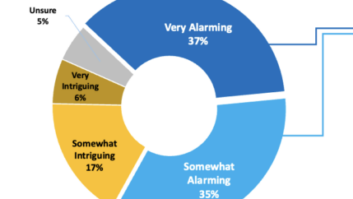(click thumbnail)These maps show predicted IBOC coverage for WNCU and KQEI, two stations in the NPR Labs’ drive-test. The presence of actual digital reception is indicated by ‘1’ along the routes; ‘0’ indicates no reception. Red-shaded areas show where the coverage model predicted interference to HD Radio service, that is, where reception would be possible in the absence of interference. Blue-shaded areas show interference-free HD-R reception.Public radio wants to know how far its digital signals are going, and how susceptible to interference neighboring analog stations are.
So the Corporation for Public Broadcasting commissioned NPR Labs to conduct a series of tests to find out.
The lab developed a computer-generated coverage prediction model for HD Radio.
The engineers developed the model from IBOC receiver tests conducted in its lab and validated it with thousands of miles of driving tests, to study the shortfall in IBOC coverage vs. FM analog coverage. It also used the model to predict interference from stations transmitting IBOC signals to adjacent analog neighbors.
John Kean, NPR Labs senior technologist, made the first public comments on the findings at the Public Radio Engineering Conference in April. The gist of the findings also was summarized in his NAB2008 Broadcast Engineering Conference paper on the topic.
CPB was reviewing the full 260+-page report in June.
The findings are seminal as the industry debates the value of, and how best to push for, FCC approval of elevated FM IBOC power.
Overall, the results show the best FM IBOC coverage in cars, and a dramatic drop-off in digital coverage for home receivers.
While an IBOC power increase would most benefit home listening, the resulting increased interference would likely hurt analog mobile coverage, Kean told Radio World.
Any power increase would need to be approved with care, he said, noting that NPR itself hasn’t taken a position on the elevated power issue.
Predicted coverage
In general, based on terrain-sensitive, computer model-predicted coverage comparing listeners with a protected signal to station IBOC coverage, the lab found mobile reception for FM IBOC was 70 to 90 percent of analog, on a population basis, using data from the 2000 U.S. Census. Indoor and portable reception were both 50 to 60 percent of the analog.
The computer model includes the total number of people predicted to be served assuming all stations in a market are transmitting both analog and digital signal.
“Service” for digital is straightforward; signal is either there or it’s not. For analog, the lab used the criterion of stereo weighted quasi-peak audio signal-to-noise ratio of 40 dB. If the audio dropped below 40 dB due to noise or interference, that didn’t count as population getting audio service, Kean said.
Coverage predictions were validated by drive tests at 10 public stations and one commercial station, CBS-owned WJFK(FM), Washington, chosen because it is local to NPR Labs and has known interference from two adjacent-channel stations to its north, WWMX(FM) in Baltimore and WWEG(FM) in Hagerstown, Md.
Kean used WJFK to verify whether his model could predict interference reliably.
The lab created a portable measurement system and conducted field strength measurements in indoor settings in the Washington area such as shopping malls, homes and offices.
Kean said Senior Engineer Jan Andrews gathered HD-R signal data while carrying a normal mode helix antenna that Kean designed. The antenna delivered gain like that expected from a three-foot-tall model, though Kean’s was shorter. It was preferable to most portable antennas, and the lab staff didn’t want to carry a whip antenna through buildings such as a mall, Kean said.
NPR Labs performed driving tests on WAMU and WJFK, while Cavell, Mertz & Associates conducted drive testing for 10 FM public stations: WBEZ, Chicago; WHRV, Norfolk, Va.; WFYI, Indianapolis; KXPR, Sacramento; WNCU, Durham, N.C.; KVPR, Fresno, Calif.; KQEI, North Highlands, Calif.; WMUB, Oxford, Ohio; KMPO, Modesto, Calif.; and WWFM, Trenton, N.J.
The stations singled out for drive tests are of differing class sizes and amounts of known interference.
Interference on IBOC reception behaves differently than on analog, said Kean. Listeners have told station engineers that if they drive from a station in one direction, the IBOC reception is good, but if they drive in another direction, it drops out.
As far as he knows, Kean said, no other IBOC coverage maps in use today consider predicted interference.
Don’t show predicted interference
He computed the impact of interference on both analog and IBOC coverage.
As for the interference impact of IBOC DAB to analog, the lab found “little or none” for most stations tested but “moderate to severe” interference for a minority of stations.
Kean didn’t assign hard numbers in his presentations, but in an interview he estimated, that, as an example, “moderate” might be a loss of around 25 percent of population served.
Increasing the IBOC power level from the current –20 dB to –10 dB causes a substantially larger amount of interference, including a larger number of stations that may lose 50 percent of their analog service population on a noise-limited service basis, according to Kean’s findings.
He considers his approach different from how HD Digital Radio Alliance stations tested elevated power levels, on which we’ve reported.
The commercial stations made audio recordings at elevated power levels, listened to them, and stated whether or not they heard interference.
NPR Labs tested consumer receivers and applied those ratios to coverage prediction models taking into account terrain characteristics and the population to determine the number of listeners whose reception would be impaired by interference.
Main findings so far:

- Mobile reception for FM IBOC was 70–90% of analog;
- Indoor and portable reception were 50–60% of the analog;
- Improved receiver & antenna performance may make up part of the coverage gap;
- Use of single-frequency networks also may help
The lab used its HD-R coverage model coupled with Terrain Integrated Rough Earth Model point-to-point software to produce field strength predictions.
In his report to CPB, which funded the studies for an undisclosed amount, Kean predicts little near-term improvement in HD-R receiver performance and said receiver performance actually may decrease given engineering pressures from price competition.
Ways to boost IBOC service include improving receiver performance as well as that of indoor and portable antennas, he said. Single-frequency networks also might be used to make up part of the coverage shortfall.
Though NPR Labs is using its model to test FM stations, it can be applied to AM with adjustment for interference ratios pertinent to IBOC in this band. Daytime and nighttime coverage could be predicted using groundwave and skywave field strength values, much as analog AM is predicted today.
Model a ‘big task’
The back story of how NPR’s IBOC coverage prediction model came to be is interesting.
While the National Radio Systems Committee tested transmission characteristics and compatibility of HD Radio before recommending FCC adoption, Kean said the NRSC paid less attention to actual FM IBOC coverage, especially in the presence of signal interference from neighboring stations that occupy first- or second-adjacent channels.
NPR wanted to determine the IBOC coverage relative to analog FM, as well as potential interference impact on analog stations. No HD-R coverage prediction model existed, he said; developing one was “a big task.”
Kean said NPR Labs’ prediction model now is providing remarkably accurate predictions of IBOC digital radio coverage. “For every measurement second, it correctly predicted whether radio could receive IBOC 90 percent of the time.”
He can also now predict when there will be no IBOC reception.
The model is based on thousands of miles of drive-test data as well as indoor testing. In the first round of receiver tests, the lab reviewed 35 analog and 15 IBOC radios. In the second round, it tested 40 radios, a mixture of analog and HD-R receivers.
Each radio required up to six hours of testing, including 118 tests and up to 4,200 measurements per radio.
The lab has made IBOC coverage prediction maps, delivered to CPB, for some 850 CPB-qualified public radio stations.
NPR Labs also conducted interference susceptibility tests on IBOC receivers in a controlled setting.
In general, at 30 dB listeners rated the audio as poor. At 25 dB a majority claimed they would turn the radio off the interference was so bad, according to Kean.
NPR Labs is testing consumer radios and conducting field measurements of mobile and indoor reception, and Kean said it will continue to do so.
The more measurements the industry collects, the more it will know about how the next generation of HD-R receivers will behave, he told RW.
The lab also studied the impact of IBOC on FM translators, using prediction models of field strength from first-, second- and third-adjacent channels. This material was included in its report to CPB but not publicly presented in detail.
NPR Labs is conducting the tests with grant funding from CPB, which is concerned about potential disenfranchisement of listeners due to the loss of services during and after the conversion of public stations to digital. NPR has filed a provisional patent application for the model.












